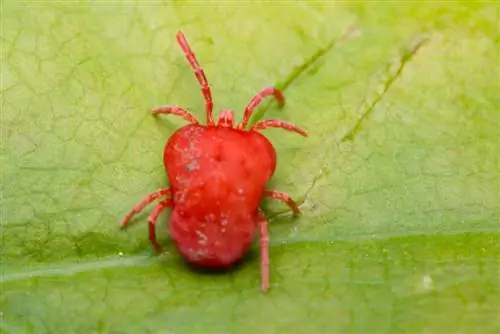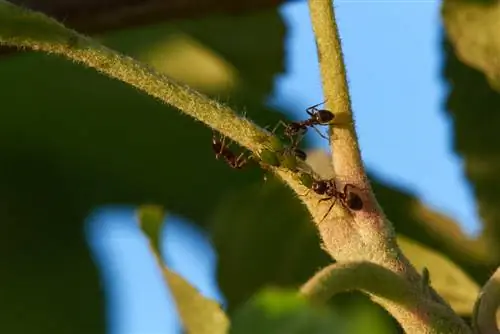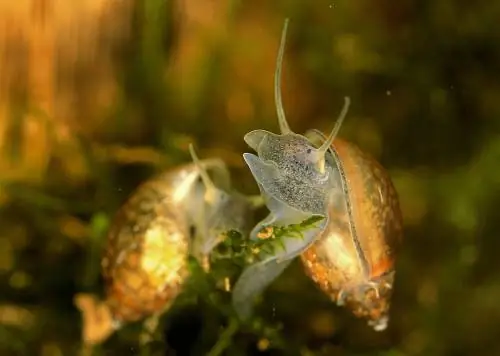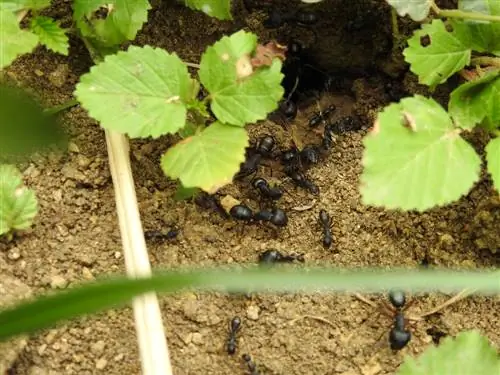- Author admin [email protected].
- Public 2023-12-16 16:46.
- Last modified 2025-06-01 06:02.
When numerous tiny, red spiders populate the garden or patio floor again from early summer onwards, many garden owners worry about their plants. This is usually not necessary at all, because the red velvet spider is a predatory walking mite and is very useful.
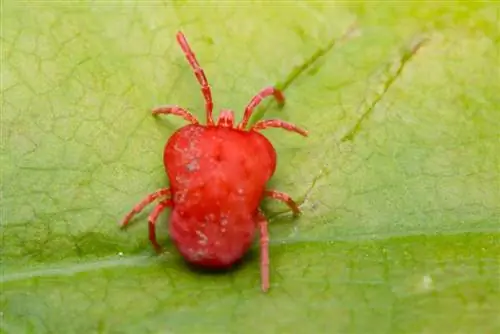
Why is the red velvet mite useful in the garden?
The red velvet mite (Trombidium holosericeum) is a useful garden insect that eats pests and their eggs. They prefer warm, dry environments and are harmless to people and pets. Control is not necessary as they contribute to humus formation and pest control.
- Red velvet mite is one of the beneficial insects in the garden as it destroys plant pests and their eggs.
- It is particularly common in warm and dry places, e.g. B. on the terrace or in the living room.
- However, it can be kept away with simple means (insect screen, pollen net).
- The species is easy to deal with externally very similar pests, e.g. E.g. the fruit tree spider mite.
What is the red velvet mite?
The bright red colored red velvet mite (Latin: Trombidium holosericeum), which is between one and four millimeters in size, is a native representative of the so-called walking mites. The animals are also popularly known as velvet mites or mites and are widespread.
In the summer months - but especially in autumn, when it gets cooler - they like to make themselves comfortable in houses and apartments, after all they are looking for a suitable option for overwintering. The red velvet mite is a predatory species of mite and feeds primarily on other insects and their eggs.
Little red spiders in the garden or on the terrace? Recognizing and distinguishing species
Not every red arachnid that crawls in your garden or on your living room carpet is a red velvet spider. There are many different small, red arachnids, and some of them are actually not welcome in the garden. So before you pull out the bug spray or try to fight the red velvet mite in another way, first take a look at what type it actually is. View article
The useful red velvet mite is particularly often confused with the fruit tree spider mite or red spider. Therefore, the following table gives you an overview of the species-typical characteristics to help you differentiate better.
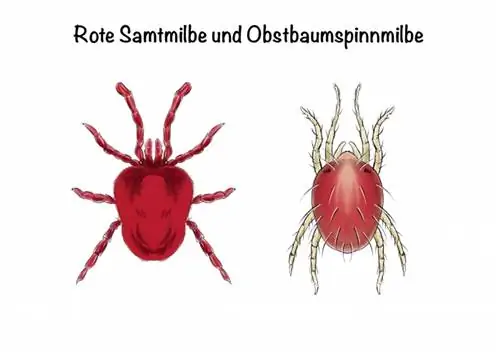
| Red velvet mite | Fruit tree spider mite | |
|---|---|---|
| Latin name | Trombidium holosericeum | Panonychus ulmi |
| Popular names | velvet mite, mite, blood animal | Red Spider |
| Size | 1 to 4 millimeters | 0.5 to 06 millimeters |
| Hair | densely hairy body, looks velvety | none, but females have prominent bristles on their back |
| color | scarlet | carmine red |
| Typical body features | long forelegs, scissor-like jaw claws, enlarged abdomen | not very pronounced, clumsy |
| Head | relatively large, small eyes | significantly smaller head |
| Occurrences | often on walls, terraces, dry lawns | mainly on trees, e.g. E.g. fruit trees and vines |
Is the red velvet mite dangerous?
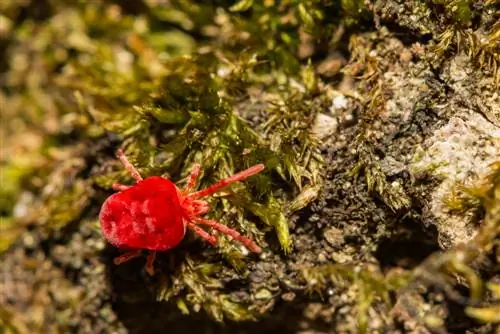
The velvet mite is not dangerous for humans or pets
No, the red velvet mite is not dangerous - at least not for people, pets or garden plants. The little animals are actually only interested in other ground-dwelling, soft-skinned insects that they hunt and suck out. However, they prefer to eat insects, especially pests that are often found in the garden, and thus reduce their population.
If the species is often found on your terrace or even in your apartment, then there is a very simple reason: it is already warm and dry there. The mites prefer such a climate, not only (but especially) in autumn when they are looking for a suitable place to overwinter.
How do I recognize the bite of the red velvet mite?
Since the red velvet mite has no stinger, it cannot sting. Their mouthparts are also not pronounced enough to penetrate human skin. This means that this species cannot bite! A possible mite bite can be traced back to completely different species, such as these:
- Autumn or harvest mite: yellow to pale red, tiny mites that prefer to stay in damp places in the garden (including compost) and are often responsible for extremely itchy bites
- Grave or scabies mite: Sarcoptes scabiei, caused by burrowing in the skin scabies
- Bird mites: Infestations occur more frequently in bird keepers (chickens, pigeons, etc.), but can also be transmitted by infested garden birds (e.g. through contact with contaminated nests)
- Grass mites: Grass mites are very common in the garden and like to bite
Typical mite bites are:
- red spots on the skin
- often not occur individually, but multiple times (multiple bites)
- itchy a lot
- Causers have often already disappeared, so itchy spots are usually inexplicable
Excursus
Does the red velvet mite actually transmit Lyme disease?
It is often claimed that the red velvet mite transmits Lyme disease. However, the likelihood of this happening is extremely small - after all, the animals are not bloodsuckers that would bite or sting people. However, the disease can certainly be transmitted by other types of mites (see above) or, above all, ticks.
Do I have to fight the red velvet mite?

Red velvet mites should not be fought but encouraged
The red velvet spider is considered a particularly beneficial insect, because the busy little animal eats with great appetite all kinds of insects that are harmful to garden plants, such as aphids or snail eggs. To do this, the adult animals not only run around on the ground, but also on walls and plants. So if you spot red arachnids on your vine or apple tree, it is not automatically a fruit tree spider mite - instead, it could also be a red velvet spider hunting for the fruit tree spider mite.
By the way, it is sometimes claimed that the animal itself would occasionally tap plant sap. This is incorrect because it is purely a hunter. The error is probably caused by confusion with the fruit tree spider mite, which is also known as the “red spider” and is very similar in appearance.
Consequently, fighting the red velvet spider makes little sense, after all, you would be depriving yourself of an important comrade-in-arms against the pest infestation in the garden.
Fascinating footage of hunting red velvet spiders is shown in the following video:

Red velvet mite is important for he althy soil
Not only does the red velvet mite destroy harmful insects and their eggs, it is also important for the garden for another reason: it is part of the soil arthropods that maintain the structure of the soil and is also relevant for humus formation. The species spends two stages of development in the soil surface, where it feeds on bacteria and fungi in addition to soil-dwelling insects and insect eggs. Therefore, it contributes to the breakdown of soil components and thus to the formation of humus, which is so important for plant growth.
Red velvet mite in the house? This is how you get rid of the little animals
Sometimes, however, there are too many animals on the terrace or even in the apartment that you would like to get rid of them despite all the advantages. This works best with the following methods.
Excursus
Red arachnids in the chicken coop
If you see small red arachnids crawling around in the chicken coop or even on the chickens, it could possibly be the red bird mite. You should fight these immediately, as this little bloodsucker causes considerable damage to the chickens. Red bird mites grow to a maximum size of about one millimeter and do not have velvety hair.
Hose the terrace with water
Red velvet mites particularly like to stay in dry places. You can easily drive the animals away from your terrace or living room by keeping the surfaces moist. You should therefore regularly spray stone surfaces with a garden hose, with the main focus being on buildings made of natural stone. Water the garden - and especially the lawn! - more frequently during more intense dry periods and don’t forget to wipe down the garden furniture too.
Build a barrier made of thick glass
A defensive barrier made of thick glass embedded in the ground (e.g. thick-walled glass blocks) has also proven to be useful, because the red velvet mite (and some other annoying species of insects and mites) find it quite unpleasant to be over one to walk on such a surface. In this way, you can reliably keep the animals away on the terrace and in the house and also create an attractive decorative element.
Keep doors and windows closed
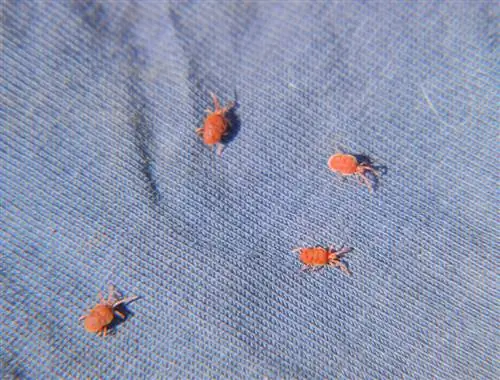
Velvet mites are not welcome in the house
So that the little crawlers don't get lost in your apartment, you should keep doors and windows closed, especially overnight. During the evening hours, red velvet mites look for a warm place to spend the night and therefore like to wander into houses. However, if all openings are closed, the animals have to stay outside. Caution: Red velvet mites can also get through cat flaps and doors or windows that don't close tightly. Because of their small size, they can exploit virtually any gap. Another disadvantage of this method is that very few people like to close all doors and windows in the summer.
Excursus
Do not crush red velvet mite
If you see a red velvet mite crawling around, don't crush it! The little animals leave red stains that are very difficult to remove from (light-colored) clothing or patio floors. It is not for nothing that they are popularly referred to as “blood animals”.
Install insect screen
Especially if you live on the ground floor or mezzanine of a house or have a terrace looking out into the garden, your home can sometimes be full of small red arachnids. It is warm and dry in your apartment, which the red velvet mite really appreciates and is therefore happy to take advantage of. It is therefore best to keep the arachnids away from the outset with a close-meshed insect protection net (€13.00 on Amazon) or mesh. Such devices are easy to install and also offer the advantage that they also reliably keep other annoying types of insects away. In addition, you can now leave doors and windows open to your heart's content.
Vermin spray - yes or no?
“Do you really have to kill everything right away just because you’re disgusted by it?”
If nothing else works, you can also use bug spray to spray an odor barrier around the terrace or in front of the patio door. These agents are more effective than traditional bug spray, which tries to kill the mites (and is not really successful). However, under no circumstances should you use these products indoors (poisons!) and think carefully before using them. Biocides not only work against the red velvet mite, but also have other serious disadvantages:
- Effect lasts between six weeks and six months, depending on the product.
- Biocides also work against other insects (bees, bumblebees), some of which are important for the garden.
- They are also extremely toxic to aquatic organisms.
- Therefore, they may heavily contaminate water sources in the garden.
- Biocides irritate the skin and mucous membranes.
- If used incorrectly, it can cause eczema, rashes or cracks in the skin.
Nevertheless, such a chemical odor barrier can be useful if, for example, the population of the red velvet spider gets out of hand and you don't know what else to do in view of the sheer mass.
Frequently asked questions
How common is the red velvet mite?
The red velvet mite is widespread in central and southern Europe. It does not prefer any special habitats, but is just as common in mixed forests, between rocks, in the dry desert and in gardens as in apartments and houses. From late spring and throughout the summer, the small animals can be seen scurrying across the ground, sometimes appearing in larger numbers.
What does the red velvet mite eat?
The red velvet mite is a predatory mite and lives parasitically on other insects even as a nymph. Here it sucks the tissue fluid of its host for several days - harvestmen (Opilio parietinus), for example, are often affected - but only very rarely blood. As an adult, it hunts ground-dwelling insects and their larvae, such as fringed beetles, small caterpillars, grasshoppers, mosquitoes, leaf lice and phylloxera, other mites and their eggs. The red velvet mite can eat up to 40 aphids per day.
How can I distinguish between harmful and beneficial types of mites?
Red spider or red velvet spider? Pest or beneficial? In the garden, this distinction can be very important and should not be made hastily. However, the speed of movement gives you an indication of the possible species: Predatory mites (such as the useful red velvet spider) generally move quickly and are constantly scurrying around the garden. Pests (such as the red spider or fruit tree spider), on the other hand, are rather slow. No wonder, after all, an apple tree can't run away.
Help, I found a red spider in my hair! What should I do now?
Nothing at all, except maybe carefully taking the little spider out of your hair. Red velvet spiders are not interested in people and do not bite or sting them, even other species of red spiders are harmless and only landed on your head by chance. So keep calm and don't worry.
What does the red velvet mite do in winter?
Red velvet mites like to spend the winter where it is warm and dry. The animals normally bury themselves in the upper layers of the soil, where they survive the cold season and then emerge as adults the following spring. The small mites can live up to a year.
Tip
A pollen net, usually intended for people who are allergic to all kinds of pollen, also keeps the red velvet mite out of the house and apartment.

